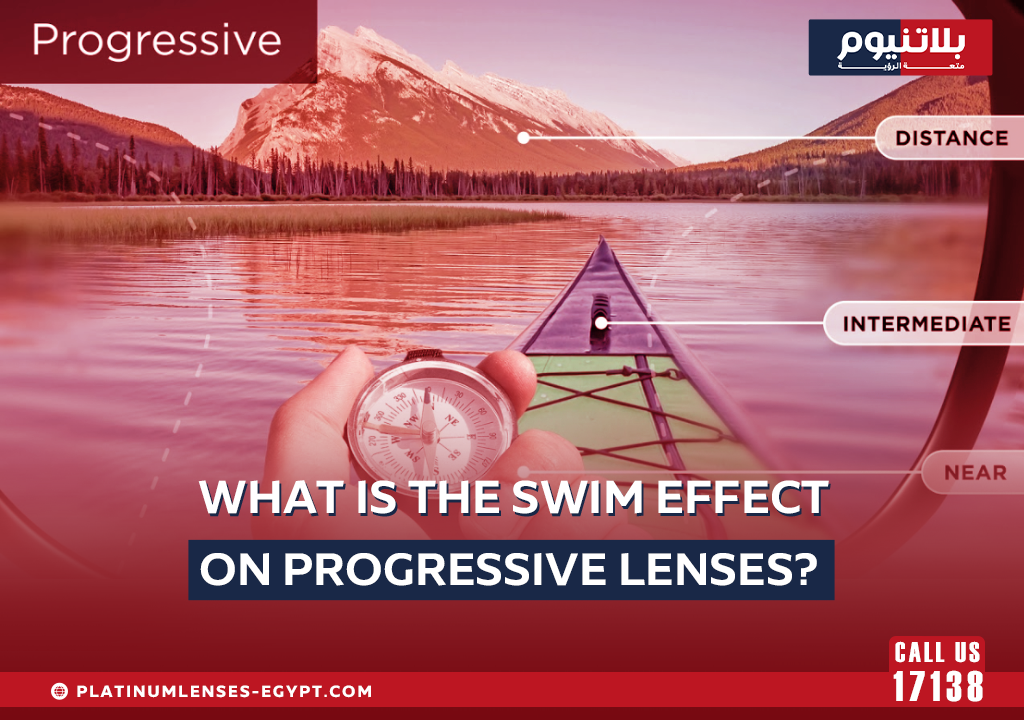Progressive lenses are a modern vision correction solution designed to provide a seamless transition between multiple vision zones—near, intermediate, and distance. Unlike traditional bifocal or trifocal lenses, which have visible lines separating different prescriptions, progressive lenses offer a smooth gradient of power. This design allows wearers to see clearly at all distances without the abrupt shifts in focus that occur with older lens styles.
Definition of the Swim Effect and How It Impacts Vision
The swim effect is a common visual distortion experienced by some progressive lens wearers, particularly when moving their head or eyes quickly. This effect creates the sensation that objects in peripheral vision are shifting, swaying, or warping unnaturally. It often occurs due to the way progressive lenses transition between different prescriptions across the surface of the lens, leading to peripheral aberrations.
For some wearers, the swim effect can be mild and easy to adjust to, while for others, it may cause noticeable discomfort. The distortion can be particularly unsettling when walking down stairs, making quick movements, or navigating dynamic environments.
Why Understanding the Swim Effect is Important for Progressive Lens Wearers
Understanding the swim effect is crucial for anyone considering progressive lenses, as it helps set realistic expectations for adaptation. While modern lens technology has significantly reduced this issue, it can still occur in some designs. By learning about its causes and solutions, wearers can make informed decisions when selecting lenses and work with their opticians to choose a design that minimizes distortions.
Causes of the Swim Effect in Progressive Lenses
The swim effect originates from the way progressive lenses distribute different prescription powers across the lens surface. Since progressive lenses do not have distinct separations between vision zones, they gradually shift in power from top to bottom. This transition results in peripheral regions of the lens containing areas with unwanted distortions, which can cause objects to appear as if they are moving or shifting unnaturally when the wearer turns their head.
The Role of Lens Curvature in Causing the Swim Effect
The curvature of a progressive lens plays a significant role in how distortions appear. Traditional progressive lenses rely on a general design template that does not fully account for individual visual behavior. This means that certain areas of the lens, particularly the outer edges, can induce peripheral aberrations, leading to the swim effect.
Newer digital freeform progressive lenses help address this issue by using customized calculations to optimize the curvature based on the wearer’s prescription, pupillary distance, and lifestyle.
How Rapid Head or Eye Movements Amplify the Issue
The swim effect is most noticeable when a wearer moves their head quickly from side to side or when shifting focus between different objects. Because the distortion is present in the peripheral areas of the lens, sudden movements can make it more pronounced, causing discomfort or disorientation.
Activities such as looking down while walking, checking side mirrors while driving, or turning to read something off to the side can trigger the swim effect. The faster these movements occur, the harder it becomes for the brain to compensate, leading to an unsettling visual experience.
How the Swim Effect Affects Daily Activities
One of the most common complaints among new progressive lens wearers is the difficulty in walking, especially when navigating stairs. Due to the way progressive lenses are designed, the lower portion of the lens contains the near-vision prescription. When wearers look down while walking, they may unintentionally view their surroundings through this near-vision zone, making objects appear larger, closer, or distorted.
This effect can create a sense of imbalance or hesitation, especially when descending stairs. Some individuals feel as though the steps are shifting or curving, making it difficult to judge depth accurately. As a result, wearers may need extra time to adjust to their lenses before feeling confident moving around.
Difficulties with Driving and Quick Focus Shifts
Driving requires constant eye movement to scan the road, check mirrors, and monitor traffic signals. However, the swim effect can make quick head or eye movements feel unnatural, particularly when looking through the peripheral areas of progressive lenses.
For example, when glancing at the side mirrors or checking blind spots, the distortions caused by the swim effect can make objects appear warped or misaligned. This can be disorienting, especially for new progressive lens users who have not yet adapted to the optical changes.
Discomfort When Reading or Using Digital Screens
Reading and using digital screens involve frequent focus shifts between different distances. With progressive lenses, the near-vision zone is located at the lower portion of the lens, which means wearers must look downward to see clearly. However, if they slightly tilt their head or move their eyes outside of the optimal viewing area, they may experience blurriness or warping due to the swim effect.
Additionally, prolonged digital screen use can amplify visual discomfort. Many progressive lens users experience difficulty maintaining a stable focus when reading text or scrolling through content. This can lead to increased eye strain and a longer adaptation period before the lenses feel natural.
How Advanced Lens Technology Reduces the Swim Effect
One of the most significant advancements in progressive lens technology is the development of digital freeform lens designs. Unlike traditional progressive lenses, which use pre-set curvature patterns, freeform lenses are customized using advanced computer-controlled surfacing techniques. This allows for:
- A more precise distribution of optical power across the lens surface.
- Reduced peripheral distortions that contribute to the swim effect.
- Enhanced clarity and a more natural visual experience, even when making quick eye or head movements.
By optimizing the lens structure, digital freeform designs ensure smoother transitions between vision zones, minimizing the sensation of image displacement.
The Role of AI-Based Customization in Improving Vision Stability
Artificial Intelligence (AI) has revolutionized lens customization by allowing manufacturers to create lenses tailored to an individual’s unique visual behavior. AI-driven customization takes into account:
- The wearer’s prescription strength and pupillary distance.
- Their head and eye movement patterns.
- Lifestyle factors such as digital screen usage or frequent driving.
By analyzing these factors, AI-powered lenses provide a more personalized visual correction experience, significantly reducing distortions that lead to the swim effect.
How IOT Digital Ray-Path 2 Technology Minimizes Distortions
IOT Digital Ray-Path 2 is one of the most innovative lens optimization technologies available today. It goes beyond conventional progressive lens design by integrating real-time accommodation calculations. This means that:
- Each lens is designed to match the wearer’s natural eye movements.
- Peripheral aberrations are minimized, resulting in a clearer and more stable field of view.
- Distortions are actively reduced in all vision zones, ensuring a seamless transition between near, intermediate, and distance vision.
With IOT Digital Ray-Path 2, wearers experience greater comfort, faster adaptation, and a more natural visual perception—making it an excellent choice for those who struggle with the swim effect in traditional lenses.
Choosing the Right Progressive Lenses to Avoid the Swim Effect
One of the key factors in minimizing the swim effect is ensuring that progressive lenses are professionally fitted. A poorly fitted lens can exacerbate distortions and discomfort, making adaptation more difficult. During a professional fitting, an optician will:
- Measure the wearer’s pupillary distance and frame alignment.
- Assess how the lenses sit on the face to ensure optimal positioning.
- Recommend lens designs that best match the wearer’s lifestyle and visual needs.
Choosing customized lenses that account for head posture and eye movement patterns can significantly enhance vision stability.
Comparing Standard Progressive Lenses vs. Advanced Designs
Not all progressive lenses are created equal. When selecting a lens, it’s important to understand the differences between standard and advanced designs:
| Feature | Standard Progressive Lenses | Advanced Progressive Lenses (e.g., Digital Ray-Path 2) |
|---|---|---|
| Customization Level | Generic design template | Tailored to individual prescription and habits |
| Peripheral Distortions | Higher distortion levels | Significantly reduced distortions |
| Adaptation Time | Longer adjustment period | Faster and smoother adaptation |
| Visual Comfort | May cause visual fatigue | Enhanced comfort for extended use |
| Technology Used | Conventional manufacturing | AI-driven, freeform digital optimization |
For those sensitive to the swim effect, advanced lenses provide a superior visual experience by reducing unwanted distortions and improving stability.
Tips for Adapting to New Progressive Lenses More Easily
Even with advanced technology, some wearers may need time to adjust to new progressive lenses. Here are a few tips to help with adaptation:
- Wear the lenses consistently to allow the brain to adjust more quickly.
- Move the head, not just the eyes when shifting focus to avoid peripheral distortions.
- Start in familiar environments before using the lenses in more dynamic settings like driving.
- Choose a frame with proper fit and size to ensure the best visual alignment.
- Give it time—most people adjust within a few days to a few weeks.
By selecting the right lens technology and following these adaptation techniques, wearers can significantly reduce the impact of the swim effect.

